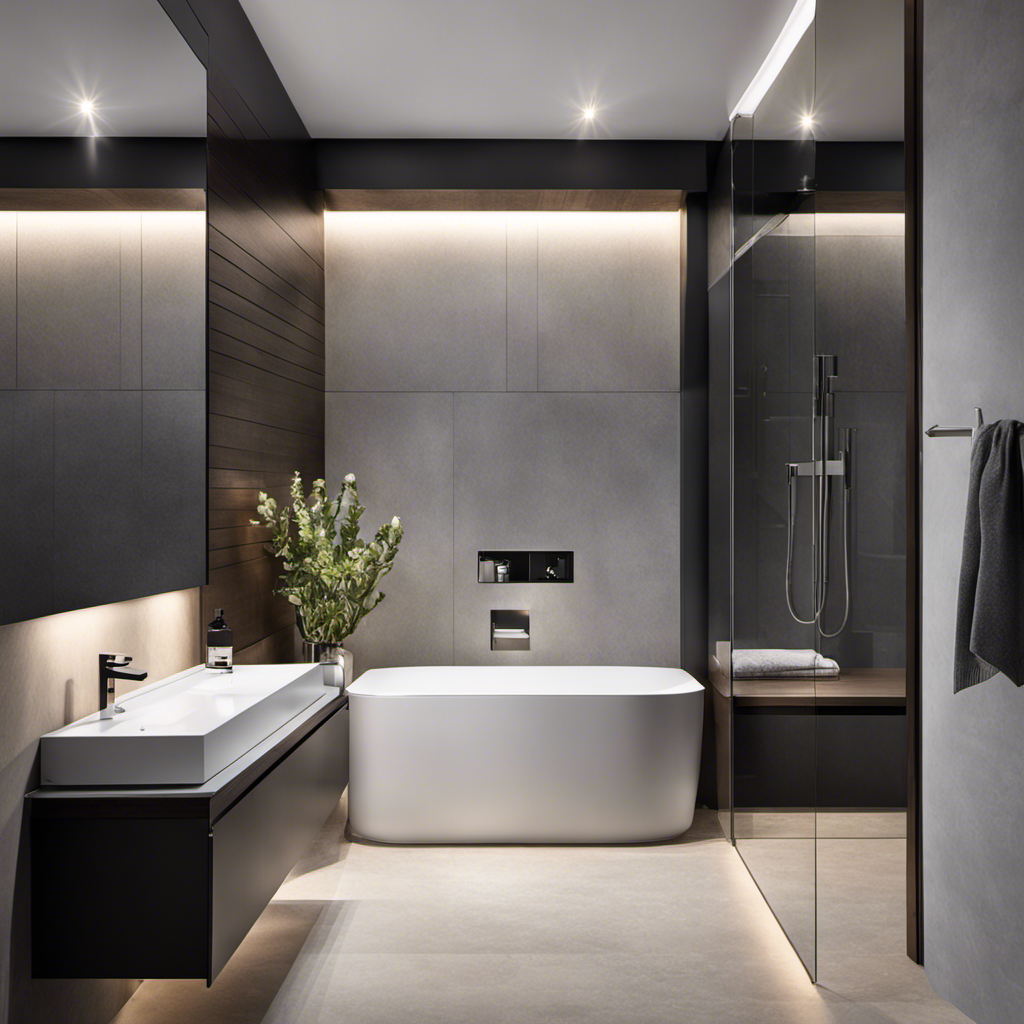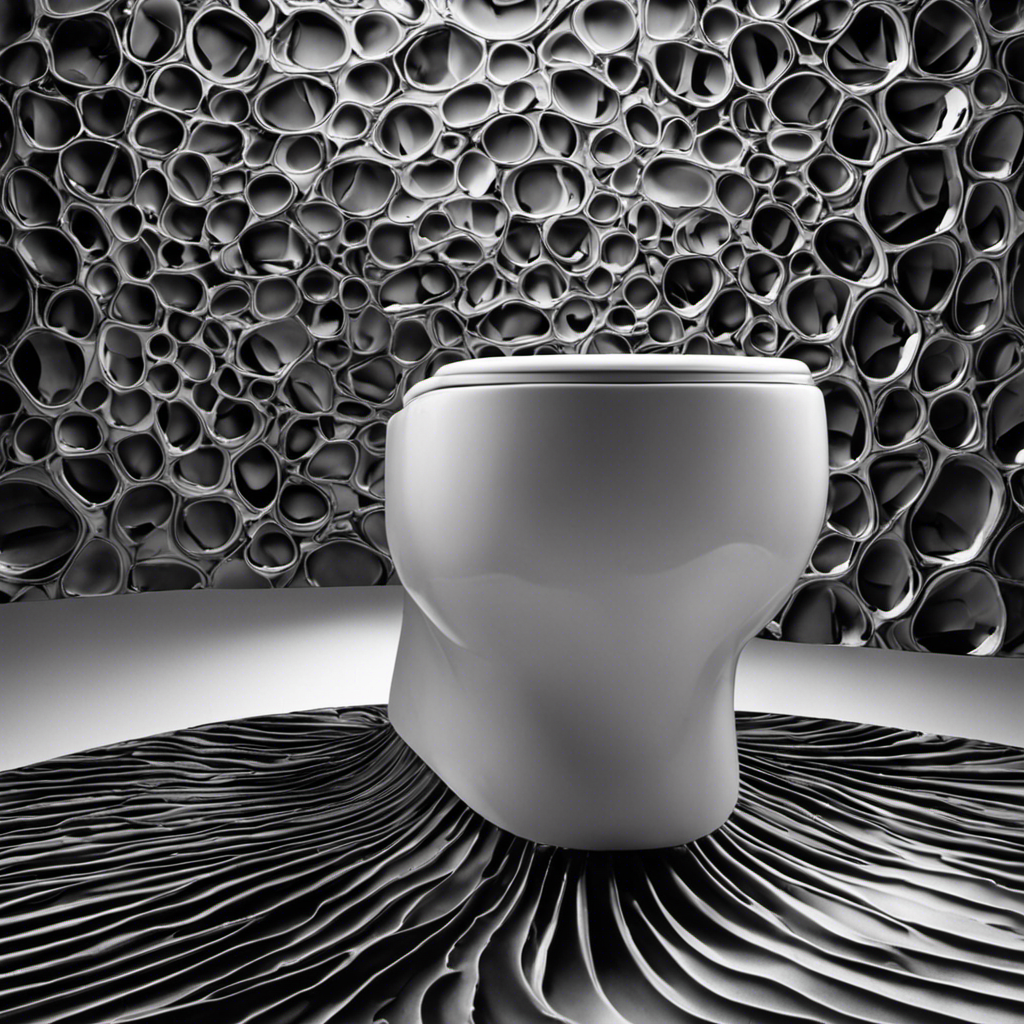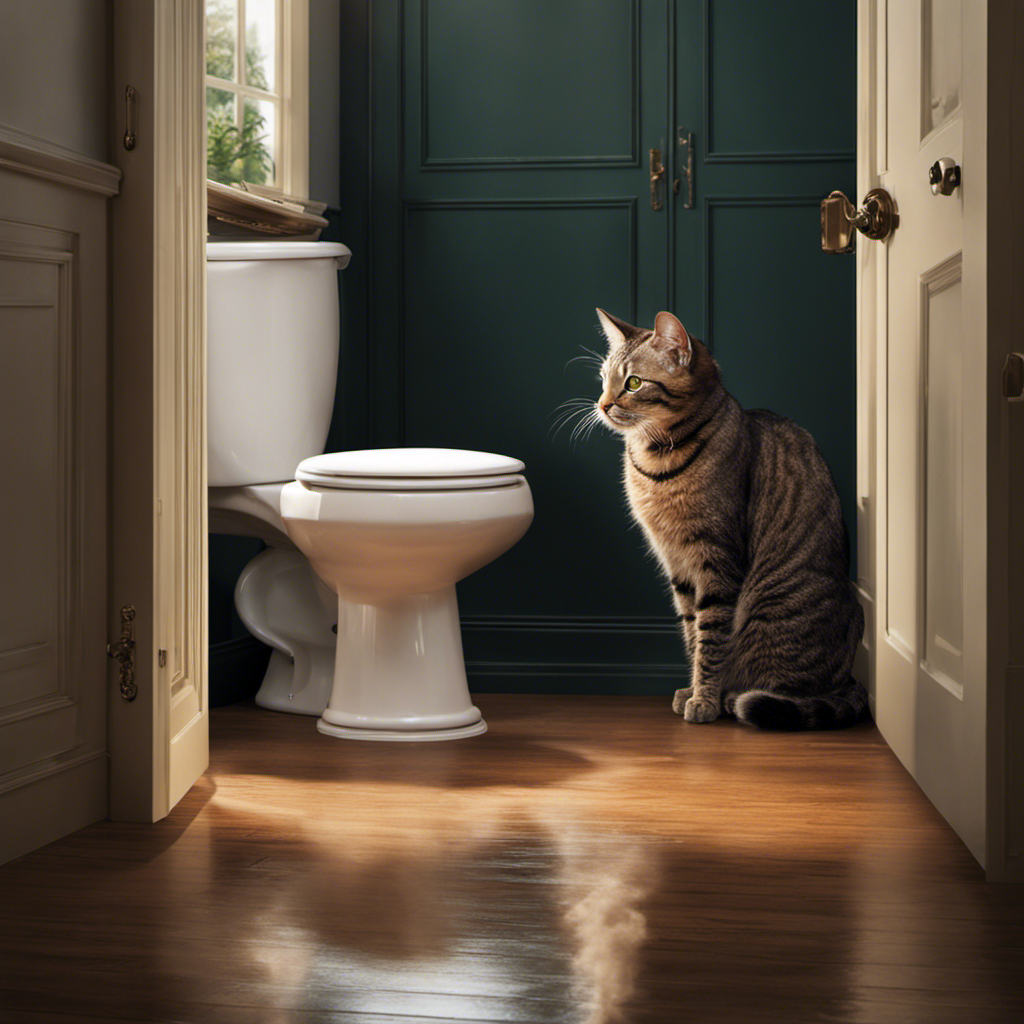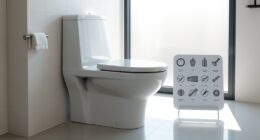As someone who loves to keep up with the latest bathroom innovations, I couldn’t help but be intrigued by the concept of a macerator toilet. This ingenious device uses cutting blades and a powerful pump to break down waste into a fine slurry, which can then be easily transported through small pipes.
In this article, we’ll explore how a macerator toilet works, the benefits of using one, and provide a step-by-step guide for installation.
So, let’s dive in and uncover the wonders of this modern marvel!
Key Takeaways
- Macerator toilets are a type of toilet that break down waste into a fine slurry for easy flushing.
- They are designed to be space-saving and are ideal for small bathrooms or limited spaces.
- Macerator toilets can be installed in various locations, including unconventional spaces like basements, attics, boats, or RVs.
- They offer efficient waste disposal through the plumbing system, reduced risk of clogs or blockages, and lower water usage compared to traditional toilets.
How Does a Macerator Toilet Work
To understand how a macerator toilet works, you’ll be amazed at how it grinds waste into tiny particles before flushing them away.
A macerator toilet consists of a powerful motor and a macerating unit that turns solid waste into a fine slurry. The waste is then pumped through small pipes into the main sewage system.
When choosing a macerator toilet, there are a few things to consider. First, you need to ensure that the unit is compatible with your existing plumbing system. Additionally, look for a macerator toilet that has a high-quality motor and a durable macerating unit.
Now, let’s explore the benefits of using a macerator toilet compared to traditional toilets.
Benefits of Using a Macerator Toilet
When it comes to waste disposal, a macerator toilet offers an efficient solution. It breaks down waste into small particles, allowing for easy and efficient disposal through the plumbing system.
Its powerful grinding mechanism ensures that waste is thoroughly broken down, reducing the risk of clogs or blockages.
Additionally, its space-saving design makes it a practical choice for small bathrooms or areas with limited space. It can be installed in tight corners or even below ground level, maximizing the use of available space.
Moreover, the installation process of a macerator toilet is straightforward and hassle-free. It does not require major renovations or extensive plumbing work.
This makes it a convenient option for both homeowners and contractors. It saves time and effort during the installation process, making it a cost-effective choice.
Efficient Waste Disposal
You can easily dispose of waste efficiently with a macerator toilet. These toilets use a powerful macerating unit to break down waste into a fine slurry, allowing it to be easily flushed away through smaller pipes.
Here are some key benefits of using a macerator toilet:
-
Space-saving: Macerator toilets require less space than traditional toilets, making them ideal for small bathrooms or installations where plumbing access is limited.
-
Versatility: Macerator toilets can be installed in a variety of locations, including basements, attics, and even boats or RVs.
-
Easy installation: These toilets can be easily retrofitted into existing plumbing systems, eliminating the need for extensive renovations.
-
Reduced water usage: Macerator toilets use less water per flush compared to traditional toilets, helping to conserve water resources.
-
Environmental impact: By reducing water usage and providing efficient waste disposal, macerator toilets have a lower environmental impact compared to other toilet systems.
Overall, macerator toilets offer a convenient and eco-friendly solution for waste disposal, making them a popular choice for many homeowners and businesses.
Space-Saving Design
The space-saving design of macerator toilets makes them a practical choice for small bathrooms or areas with limited plumbing access. These toilets are designed to be compact and efficient, allowing them to fit into tight spaces without sacrificing functionality.
The macerator system, housed within the toilet, breaks down waste into small particles, which are then easily transported through the plumbing system. This eliminates the need for a traditional gravity-fed system and allows for flexible installation options.
In addition to their space-saving capabilities, macerator toilets also offer water-saving benefits. By using a macerator system, the toilet requires less water per flush compared to traditional toilets, helping to conserve water without compromising performance.
Overall, the space-saving design and water-saving features make macerator toilets an excellent choice for small spaces and environmentally conscious individuals.
Easy Installation Process
Installing a macerator toilet is a straightforward process that can be completed with ease. With its portable options and cost-effective solutions, it has become a popular choice for many homeowners.
Here are five key steps to successfully install a macerator toilet:
-
Begin by selecting a suitable location for the macerator toilet, ensuring it is near a water supply and a drain outlet.
-
Install the macerator unit, which will break down waste and pump it into the existing plumbing system.
-
Connect the toilet bowl to the macerator unit using the provided connectors, ensuring a secure and watertight connection.
-
Connect the water supply line to the toilet bowl and ensure proper water flow and functionality.
-
Finally, test the macerator toilet by flushing and checking for any leaks or issues.
Installing a Macerator Toilet: Step-by-Step Guide
Start by ensuring that all necessary tools and materials are readily available for the installation process of a macerator toilet. This includes a macerator toilet kit, a wrench, a screwdriver, a level, and a drill.
Follow these step-by-step instructions for a successful installation:
- Begin by locating the ideal spot for your macerator toilet, keeping in mind the required plumbing connections.
- Use the level to ensure that the floor is flat and even.
- Install the macerator pump unit according to the manufacturer’s instructions, connecting it to the existing plumbing.
- Secure the toilet bowl to the macerator pump unit, making sure it is properly aligned.
- Connect the water supply line and test for any leaks.
- Finally, turn on the power and test the macerator toilet’s functionality.
Maintenance and Cleaning Tips for Macerator Toilets
When it comes to maintaining and cleaning macerator toilets, there are two key points to keep in mind. First, preventing clogs and blockages. It is important to avoid flushing items that can cause damage to the macerator blades or clog the pipes, such as sanitary napkins or wet wipes. Second, choosing suitable cleaning products. Selecting cleaning products that are specifically formulated for macerator toilets will help ensure effective cleaning without causing any damage to the system.
Preventing Clogs and Blockages
To prevent clogs and blockages in a macerator toilet, it’s important to avoid flushing large amounts of toilet paper at once. This can overload the macerator blades and cause them to jam or break.
Here are some additional tips to keep your macerator toilet running smoothly:
- Use toilet paper that is specifically designed for macerator toilets.
- Avoid flushing feminine hygiene products, wipes, or any other non-biodegradable items.
- Regularly clean and maintain your macerator toilet to prevent the build-up of debris and residue.
- Consider using a macerator toilet cleaner that is specifically formulated to break down waste and prevent odors.
- If you experience any issues with your macerator toilet, such as slow flushing or strange noises, contact a professional plumber for assistance.
By following these maintenance tips, you can ensure the proper functioning of your macerator toilet and enjoy the benefits it offers, such as efficient waste disposal and space-saving design.
Now, let’s move on to the next section about choosing suitable cleaning products.
Choosing Suitable Cleaning Products
Using cleaning products specifically formulated for macerator toilets is essential to maintaining their performance and preventing any potential issues. When it comes to green cleaning and eco-friendly options, there are a few things to consider.
Look for cleaning products that are labeled as environmentally friendly or biodegradable. These products are designed to break down easily and reduce the impact on the environment. Avoid using harsh chemicals or bleach-based cleaners, as these can damage the macerator system and cause blockages. Instead, opt for natural cleaning solutions such as vinegar or baking soda. These can effectively clean the macerator toilet without causing any harm.
By choosing the right cleaning products, you can ensure the longevity and efficient operation of your macerator toilet.
With that in mind, let’s now compare macerator toilets to traditional toilets.
Comparing Macerator Toilets to Traditional Toilets
Macerator toilets have several advantages over traditional toilets. They are more compact and versatile, making them easy to install in any location, even where conventional plumbing is not available. Additionally, their space-saving design is perfect for small bathrooms or spaces where a traditional toilet may not fit. Macerator toilets also offer flexibility in plumbing layout, as they can pump waste vertically or horizontally. Another benefit is that they typically use less water per flush compared to traditional toilets, reducing water usage and lowering utility bills. Additionally, macerator toilets operate at a lower noise level, making them more discreet.
However, it is important to consider some drawbacks when using a macerator toilet. These can include potential clogs, maintenance requirements, and the need for regular cleaning.
Transitioning into the next section, I will discuss common issues and troubleshooting for macerator toilets.
Common Issues and Troubleshooting for Macerator Toilets
One common issue with macerator toilets is clogging, which can be caused by flushing items that are not intended to be flushed. To prevent clogging, it is important to only flush toilet paper and human waste. Avoid flushing items such as feminine hygiene products, diapers, or paper towels, as these can easily get stuck in the macerator pump.
If you do experience a clog, there are a few troubleshooting tips you can try. First, turn off the power to the macerator toilet and remove the obstruction manually using gloves or a tool. If that doesn’t work, you can try using a plunger specifically designed for macerator toilets.
Additionally, regularly maintaining and cleaning your macerator toilet can help prevent clogs and other common issues.
Are Macerator Toilets Suitable for Every Bathroom?
Macerator toilets may not be suitable for every bathroom due to their specific installation requirements and potential limitations. These toilets have their own set of advantages and disadvantages that should be considered before making a decision.
Here are some pros and cons of macerator toilets:
-
Pros:
-
Versatility: Macerator toilets can be installed in areas where traditional plumbing is not feasible.
-
Space-saving: These toilets are compact and can fit in small bathrooms or even under stairs.
-
Easy maintenance: The macerator unit can be accessed easily for regular maintenance and cleaning.
-
Cost-effective: Macerator toilets can be less expensive to install compared to traditional plumbing systems.
-
Flexibility: These toilets allow for flexible placement, making it possible to add a bathroom in unconventional locations.
-
Cons:
-
Noise: Macerator toilets can be louder than regular toilets due to the grinding mechanism.
-
Limited capacity: Macerator toilets have a smaller waste storage capacity, requiring more frequent emptying.
-
Installation requirements: These toilets need specific plumbing and electrical connections, which may not be feasible in all bathrooms.
-
Higher risk of clogs: The macerator unit can become clogged if improper waste materials are flushed down.
-
Maintenance costs: Macerator toilets may require more frequent maintenance and repair, leading to additional expenses.
Considering these factors, it is important to evaluate your bathroom’s specific needs and limitations before deciding if a macerator toilet is the right choice for you.
Conclusion
After learning about macerator toilets and their functioning, benefits, installation process, maintenance tips, and comparison with traditional toilets, it is clear that macerator toilets offer a convenient and efficient solution for bathroom spaces.
With their ability to break down waste and pump it away, these toilets can be installed in various locations, making them suitable for any bathroom.
While there may be some common issues, troubleshooting techniques can resolve them.
Overall, macerator toilets provide a reliable and practical option for modern bathrooms.










